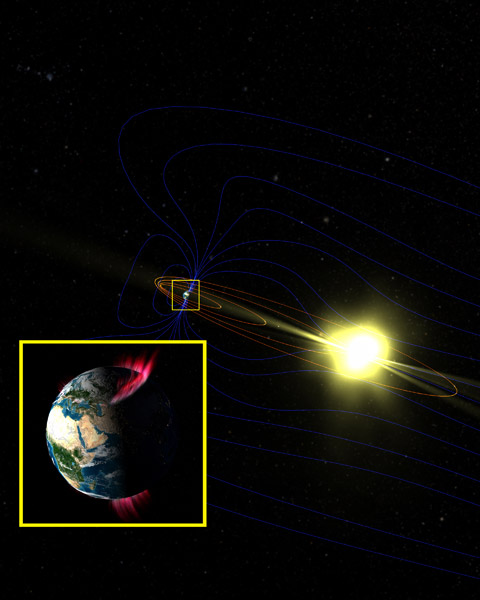Secret of Colorful Auroras Revealed

A flotillaof NASA probes has solved the 30-year mystery behind the most colorful auroradisplays on Earth and the explosive magnetic "substorms" that spawnthem.
NASA?s fiveTHEMIS spacecraft in different orbits around Earth spotted the trigger for the substorms,powerful energy bursts in the planet?s magnetic field that can interfere withsatellites, power grids and superchargethe aurora borealis, also known as the northern lights.
"We discovered whatsparks the magnificent light show of the aurora," said THEMIS principalinvestigator Vassilis Angelopoulos, a space scientist at the University ofCalifornia, Los Angeles.
Angelopoulos and his teamused the THEMISprobes to monitor the energy levels in Earth?s magnetic field. In Februaryof this year, the spacecraft spotted substorms originating in the tail of themagnetosphere that streams out away from the sun. As energy levels in themagnetic field lines built up, they drew ever closer to one another until theyreconnected, setting off a storm, researchers said.
For the last three decades,researchers were undecided on whether the substorms stemmed from magnetic fieldlines reconnecting, or originated much closer to Earth where they were triggeredby explosive instability.
"Our data show clearlyand for the first time that magnetic reconnection is the trigger," saidAngelopoulos.
The research is detailed inthe July 24 online edition of the journal Science.
Breaking space news, the latest updates on rocket launches, skywatching events and more!
Firstdiscovered in the 19th century, magnetic substorms are recurring energy burstsstemming from the release of charged particles — collected from the sun?s solarwind — in the Earth?s magnetic field. The high-energy particles zoom down theEarth?s magnetic field lines until they collide with the planet?s upperatmosphere to create dazzling,shifting colors in the aurora borealis.
Researchers hope that by betterunderstanding the storms, they will be able to prepare for or predict majorspace weather events before the cosmic tempests interfere with communicationsor endanger astronautsin Earth orbit.
"We need to understandthis environment and eventually be able to predict when these large energyreleases will happen so astronauts can go inside their spacecraft and we canturn off critical systems on satellites so they will not be damaged,"Angelopoulos said, adding that previous missions could only track bursts at asingle point and time. ?To resolve this question properly requires correlationsand signal-timing at multiple locations. This is precisely what was missinguntil now."
NASA?s$200 million THEMIS spacecraft, short for Time History of Events andMacroscale Interactions During Substorms, launched in February 2007 on atwo-year mission to hunt for the substorm source. The five dishwasher-sizedspacecraft are arranged in different orbits between the Earth and moon, and areworking in conjunction with 20 ground-based observatories across the northern UnitedStates and Canada to monitor substorm activity.
- Video:Secret of the Northern Lights Revealed
- Video:Spotlight on THEMIS Aurora Mission
- Images:Colorful Auroras

Tariq is the award-winning Editor-in-Chief of Space.com and joined the team in 2001. He covers human spaceflight, as well as skywatching and entertainment. He became Space.com's Editor-in-Chief in 2019. Before joining Space.com, Tariq was a staff reporter for The Los Angeles Times covering education and city beats in La Habra, Fullerton and Huntington Beach. He's a recipient of the 2022 Harry Kolcum Award for excellence in space reporting and the 2025 Space Pioneer Award from the National Space Society. He is an Eagle Scout and Space Camp alum with journalism degrees from the USC and NYU. You can find Tariq at Space.com and as the co-host to the This Week In Space podcast on the TWiT network. To see his latest project, you can follow Tariq on Twitter @tariqjmalik.
